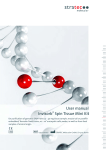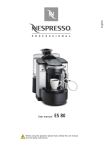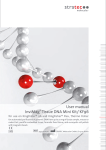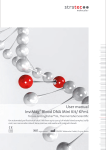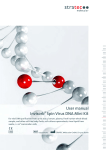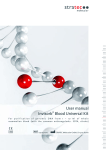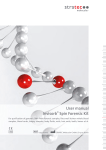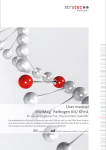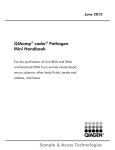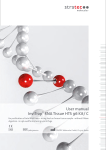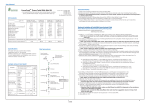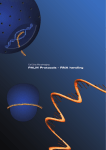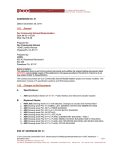Download Invisorb® Spin Tissue Mini Kit
Transcript
User manual Invisorb® Spin Tissue Mini Kit for purification of genomic DNA from 0.5 - 40 mg tissue sample; mouse tail or paraffin embedded/ formalin fixed tissue; 10 – 106 eucaryotic cells;swabs, as well as from food samples of animal origin IVD REF 1032100x00 STRATEC Molecular GmbH, D-13125 Berlin Instruction for Invisorb® Spin Tissue Mini Kit The Invisorb® Spin Tissue Mini Kit is the ideal tool using the Invisorb® technologies for manual isolation and purification of DNA from small amounts of various human and animal tissues (e.g. muscle, liver, heart and brain), biopsy material, rodent tail, paraffin embedded tissues, eucaryotic cell pellets and swabs. The kit is neither for isolation of DNA from stool samples, blood samples, bacteria, fungi, plants, or viruses, nor for purification of RNA. IVD Compliance with EU Directive 98/79/EC on in vitro medical devices. Not for in vitro diagnostic use in countries where the EU Directive 98/79/EC on in vitro medical devices is not recognized. ® Trademarks: Invisorb . Registered marks, trademarks, etc. used in this document, even when not specifically marked as such, are not to be considered unprotected by law. ® The Invisorb technology is covered by patents and patent applications: US 6,110363, US 6,043,354, US 6,037,465, EP 0880535, WO 9728171, WO 9534569, EP 0765335, DE 19506887, DE 10041825.2, WO 0034463. ® Invisorb is a registered trademark of STRATEC Biomedical AG. The PCR process is covered by US Patents 4,683,195, and 4,683,202 and foreign equivalents owned by HoffmannLa Roche AG. © 2015 STRATEC Molecular, all rights reserved. 1 ® Invisorb Spin Tissue Mini Kit 0915 Contents Kit contents of Invisorb® Spin Tissue Mini Kit 3 Symbols 4 Storage 4 Quality control 4 Intended use 5 Product use limitation 5 Safety information 6 ® Product characteristic of the Invisorb Spin Tissue Mini Kit 6 Principle and procedure .7 Sample collection and storage 7 ® Scheme of the Invisorb Spin Tissue Mini Kit 10 Important notes 11 Important points before starting a protocol 11 Preparing reagents and buffers for the Invisorb® Spin Tissue Mini Kit 11 Reagents and equipment to be supplied by user 12 Important indications 12 Protocol 1: DNA isolation from 0.5 - 40 mg tissue, biopsy sample frozen section, Insects, rodent tail (up to 1.2 cm) and food sample from animal origin 13 Protocol 2: DNA isolation from paraffin embedded tissue 14 Protocol 3: DNA isolation from formalin-fixed tissue 14 Protocol 4: DNA isolation from 10 – 106 eukaryotic cells / cell pellets 15 Protocol 5: Isolation of apoptotic DNA from 10 – 106 eukaryotic cells / cell pellets 15 Protocol 6: DNA isolation from swab or rinsed liquid 16 Troubleshooting 17 Appendix 19 Ordering information 20 2 ® Invisorb Spin Tissue Mini Kit 0915 Kit contents of Invisorb® Spin Tissue Mini Kit Store all kit components at room temperature (RT)! Dissolved Proteinase K should be stored at -20°C! 5 DNA-extractions 50 DNAextractions 250 DNAextractions Catalogue No. 1032100100 1032100200 1032100300 Lysis Buffer G 2 x 2 ml 30 ml 120 ml Binding Buffer A Proteinase K 2 x 1 ml 4 ml 2 x 9 ml (ready to use) (final volume 15 ml) (final volume 2 x 30 ml) for 250 µl for 2 ml for 5 x 2 ml working solution working solution working solution 15 ml 18 ml 2 x 45 ml (ready to use) (final volume 60 ml) (final volume 2 x 150 ml) 2 ml 30 ml 120 ml Spin Filter 5 50 5 x 50 2.0 ml Receiver Tubes 5 50 5 x 50 1.5 ml Receiver Tubes 5 50 5 x 50 Manual 1 1 1 Wash Buffer Elution Buffer Initial steps Add 250 µl dd H2O to the tube Proteinase K, mix thoroughly until completely dissolving and store at -20°C! 3 Add 11 ml 99.7% Isopropanol to the Binding Buffer A. Mix by intensive shaking by inverting for 1 min. Shortly before use mix by inverting several times. Add 21 ml 99.7% Isopropanol to each Binding Buffer A. Mix by intensive shaking by inverting for 1 min. Shortly before use mix by inverting several times. Add 2 ml dd H2O to the tube Proteinase K, mix thoroughly until completely dissolving and store at -20°C! Add 2 ml dd H2O to each tube Proteinase K, mix thoroughly until completely dissolving and store at -20°C! Add 42 ml of 96-100% ethanol to the bottle Wash Buffer, mix thoroughly and always keep the bottle firmly closed! Add 105 ml of 96-100% ethanol to the bottle Wash Buffer, mix thoroughly and always keep the bottle firmly closed! ® Invisorb Spin Tissue Mini Kit 0915 Symbols Lot number Catalogue number Expiry date Consult operating instructions Temperature limitation Do not reuse Manufacturer Storage All buffers and kit contents of the Invisorb® Spin Tissue Mini Kit, except dissolved Proteinase K should be stored at room temperature (RT) and are stable for at least 12 months under these conditions. Dissolved Proteinase K must be stored at – 20°C. Wash Buffer charged with ethanol should be stored at room temperature and should be appropriate sealed. If there are any precipitates within the provided solutions dissolve these precipitates by carefully warming up to room temperature (up to 30°C). Room temperature (RT) is defined as range from 15 - 30°C. Quality control and product warranty STRATEC Molecular warrants the correct function of the Invisorb® Spin Tissue Mini Kit for applications as described in this manual. Purchaser must determine the suitability of the Product for its particular use. Should any Product fail to perform the applications as described in the manual, STRATEC Molecular will check the lot and if STRATEC Molecular investigates a problem in the lot, STRATEC Molecular will replace the Product free of charge. STRATEC Molecular reserves the right to change, alter, or modify any Product to enhance its performance and design at any time. In accordance with STRATEC Molecular’s ISO 9001-2000 and ISO EN 13485 certified Quality Management System the performance of all components of the Invisorb® Spin Tissue Mini Kit have been tested separately against predetermined specifications routinely on lot-to-lot to ensure consistent product quality. If you have any questions or problems regarding any aspects of Invisorb® Spin Tissue Mini Kit or other STRATEC Molecular products, please do not hesitate to contact us. A copy of STRATEC Molecular’s terms and conditions can be obtained upon request or are presented at the STRATEC Molecular webpage. For technical support or further information please contact: from Germany +49-(0)30-9489-2901/ 2910 from abroad +49-(0)30-9489-2907 or contact your local distributor. 4 ® Invisorb Spin Tissue Mini Kit 0915 Intended use The Invisorb® Spin Tissue Mini Kit is the ideal tool, using the Invisorb® technology for manual isolation and purification of genomic DNA from fresh or frozen human and animal tissues, biopsy material, rodent tail, insects and paraffin embedded tissues, as well as animal origin food samples and eucaryotic cells, and cell pellets. Furthermore allow the Invisorb® Spin Tissue Mini Kit the isolation of apoptotic DNA ladders from cells. Apoptosis is a form of cell death and characterized morphologically by cell shrinkage, blebbing of the membrane and compaction of nuclear chromatin and cytoplasm. Furthermore apoptosis is associated with the activation of Ca2+ and Mg2+ depending endonucleases resulting in the double-strand cleavage of the chromosomal DNA at the internucleosomal sites. The cleavage of genomic DNA leads to fragmentation of the DNA into multiple fragments of 180bp multimeric bands. A characteristic apoptosis DNA ladder is obtained if the apoptotic DNA is resolved by a classical agarose gel electrophoresis. For reproducible and high yields appropriate sample storage is essential. The purified DNA can be used for In-vitro-diagnostic analysis only. THE PRODUCT IS INTENDED FOR USE BY PROFESSIONALS ONLY, SUCH AS TECHNICIANS, PHYSICIANS AND BIOLOGISTS TRAINED IN MOLECULAR BIOLOGICAL TECHNIQUES. It is designed to be used with any downstream application employing enzymatic amplification or other enzymatic modifications of DNA followed by signal detection or amplification. Any diagnostic results generated by using the sample preparation procedure in conjunction with any downstream diagnostic assay should be interpreted with regard to other clinical or laboratory findings. To minimize irregularities in diagnostic results, adequate controls for downstream applications should be used. The kit is in compliance with EU Directive 98/79/EC on in vitro medical devices. But it is not for in-vitro diagnostic use in countries where the EU Directive 98/79/EC on in vitro medical devices is not recognized. Product use limitation The kit is validated neither for the isolation of DNA from stool samples, blood, bacteria, fungi or viruses, nor for isolation and purification of RNA. The included chemicals are only useable once. Differing of starting material or flow trace may lead to inoperability; therefore neither a warranty nor guarantee in this case will be given, neither implied nor express. The user is responsible to validate the performance of the STRATEC Molecular Product for any particular use. STRATEC Molecular does not provide for validation of performance characteristics of the Product with respect to specific applications. STRATEC Molecular Products may be used e.g.in clinical diagnostic laboratory systems conditioned upon the complete diagnostic system of the laboratory the laboratory has been validated pursuant to CLIA’ 88 regulations in the U.S. or equivalents in other countries. All Products sold by STRATEC Molecular are subject to extensive quality control procedures (according to ISO 9001-2000 and ISO EN 13485) and are warranted to perform as described herein. Any problems, incidents or defects shall be reported to STRATEC Molecular immediately upon detection thereof. The chemicals and the plastic parts are for laboratory use only; they must be stored in the laboratory and must not be used for purposes other than intended. The Product with its contents is unfit for consumption. 5 ® Invisorb Spin Tissue Mini Kit 0915 Safety information When and while working with chemicals, always wear a suitable lab coat, disposable gloves, and protective goggles! Avoid skin contact! Adhere to the legal requirements for working with biological material! For more information, please consult the appropriate material safety data sheets (MSDS). These are available online in convenient and compact PDF format at www.stratec.com for each STRATEC Molecular Product and its components. If buffer bottles are damaged or leaking, WEAR GLOVES, AND PROTECTIVE GOGGLES when discarding the bottles in order to avoid any injuries. STRATEC Molecular has not tested the liquid waste generated by the Invisorb® Spin Tissue Mini procedures for residual infectious materials. Contamination of the liquid waste with residual infectious materials is highly unlikely, but cannot be excluded completely. Therefore, liquid waste must be considered infectious and be handled and discarded according to local safety regulation. Patient specimens must always be considered as potentially infectious. Samples from risk patients must always be labelled and handled under suitable safety conditions. Observe all federal, state and local safety and environmental regulations. Observe the usual precautions for nucleic acid applications. It is essential that all reagents and materials used for DNA isolation are free from DNases. European Community risk and safety phrases for the components of the Invisorb® Spin Tissue Mini Kits to which they apply are listed below as follows: Proteinase K: danger H315-319-334-335 P280-305-351-338-310-405 H319: H315: H334: H335: P305+P351+P338: P280: P310: P405: Causes serious eye irritation. Causes skin irritation. May cause allergy or asthma symptoms or breathing difficulties if inhaled. May cause respiratory irritation. IF IN EYES: Rinse cautiously with water for several minutes. Remove contact lenses, if present and easy to do. Continue rinsing. Wear protective gloves/protective clothing/eye protection/face protection. Immediately call a POISON CENTER or doctor/physician. Store locked up. Emergency medical information can be obtained 24 hours a day from infotrac: outside of USA: in USA : 1 – 352 – 323 – 3500 1 – 800 – 535 – 5053 6 ® Invisorb Spin Tissue Mini Kit 0915 Product characteristic of the Invisorb® Spin Tissue Mini Kit Starting material 0.5 – 40 mg tissue sample up to 1.0 cm mouse tail up to 0.5 cm rat tail biopsy material insects paraffin embedded tissues 10 – 106 eucaryotic cells swabs Yield up to 50 µg depends on type and amount of tissue samples Time for preparation Ratio 15 min after lysis A260 : A 280 1.6 – 2.1 0.2 - 1.2 µg per mg tissue/ 10 - 40 µg per rodent tail max. 6 µg from human cells max. 10 µg from animal cells The Invisorb® Spin Tissue Mini Kit use the well-established Invisorb® technology to provide an extremely fast way to isolate genomic DNA from above named starting material and amount as well as apoptotic DNA from cells. The purified DNA is free of contaminants and enzyme inhibitors and performs reliably in downstream applications such as PCR. Purifications requires no phenol or chloroform extraction or alcohol precipitation. No toxic or hazardous chemicals like chaotropic components are used. The kit is designed for simultaneous processing of multiple samples. The procedure requires minimal interaction by the user, allowing safe handling of potentially infectious samples. The procedures are designed to avoid sample-to-sample cross-contamination. Purified DNA is eluted in a low-salt buffer (without EDTA) or water. Due to the high purity, the isolated genomic DNA is ready to use for a broad panel of downstream applications (see below) or can be stored at –20°C for subsequent use. ○ ○ ○ ○ ○ PCR* Restriction Enzyme Digestion HLA Typing Sequencing Southern Blot For the isolation of genomic DNA from bigger amounts of starting material, STRATEC Molecular for high-throughput needs the Invisorb® DNA Tissue HTS 96 Kit in a convenient 96 well format, for use in a centrifuge or the InviMag® Tissue DNA Kit/ KF96 for use on a KingFisher 96 robot (see ordering information, page 26 ). For further information please contact: Phone + 49 (0) 30 9489 2901, 2910 in Germany and from foreign countries phone + 49 (0) 30 9489 2907 * The PCR process is covered by US Patents 4,683,195, and 4,683,202 and foreign equivalents owned by Hoffmann-La Roche AG. 7 ® Invisorb Spin Tissue Mini Kit 0915 Principle and procedure The Invisorb® Spin Tissue Mini Kit simple procedure comprises following steps: 1. 2. 3. 4. lysis of cells binding the genomic DNA to the membrane of a Spin Filter washing the membrane and elimination of ethanol elution of genomic DNA This manual contains 7 protocols, according to the different requirements of the starting materials Sample collection and storage: Tissue sample / biopsy material / frozen section: Best results are obtained with fresh material or material that has been immediately frozen and stored at – 20°C or – 80°C. Repeated freezing and thawing of stored samples should be avoided, since this leads to reduced DNA size. Use of poor quality starting material influences yield of purified DNA. The amount of purified DNA in the Invisorb® Spin Tissue Mini Kit procedure using 5-40 mg tissue sample, depends on kind of starting material. The thawing process could proceed, directly in Lyse Buffer G. Rodent tail: Best results are obtained with fresh material or material that has been immediately frozen and stored at – 20°C or – 80°C. Repeated freezing and thawing of stored samples should be avoided, since this leads to reduced DNA size. A long-time lysing also leads to degradation of DNA. Crushing the rodent tails reduces lysis time. Insects: Best results are obtained with fresh material or material that has been immediately frozen and stored at –20°C or –80°C. Insects especially with chitin mail must be homogenized before lysis (for example by grinding with mortar and pestle under liquid nitrogen). The sample can be stored for a short time at 2-8°C in Lysis Buffer G. Paraffin slices / formalin - fixed tissue: These samples can be stored at room temperature (RT). By appropriate paraffin embedding or formalin fixation pure DNA can be isolated from above named starting material, but paraffin embedding or formalin fixation leads to reduced DNA quality. An improper contact of the tissue with formalin will reduce dramatically the yield of DNA. Cells grown in suspension: Spin up to 1 x 108 cells for 5 min at 300 x g (1.500 rpm* ). Discard supernatant and remove all media completely, taking care not to disturb the cell pellet. At this point cells may be frozen (at -20°C or - 80°C) for future use or may be used immediately. Cells grown in a monolayer: Aspirate the media completely from the cells and continue immediately with the lysis step. Alternatively cells can be detached by trypsination (cultivation in larger culture vessels, like dishes > ∅ 35 mm, flasks > 12.5 cm2). Transfer cells to a 50 ml reaction tube, pellet by centrifugation at 300 x g (1.500 rpm* ) for 5 min and aspirate supernatant completely. 8 ® Invisorb Spin Tissue Mini Kit 0915 Buccal swabs: To collect a sample, scrape the swab firmly against inside of each cheek 6 times. Air-dry the swab for at least 2h after collection or use them fresh prepared. Ensure that the person providing the sample has not consumed any food or drink in the 30 min prior to sample collection. Best results are obtained if the swab stays in the lysis solution during lysis procedure. Use of poor quality starting material influences yield of purified DNA. This protocol is recommended for every common swab, like e.g. the following swab types: C:E:P: (Omni Swab from Whatman), cotton swab, Superswabs, Copan-Swab or DRACON tip from Hardwood Products company, CellProjects or Hain Diagnostika) CSF and Bone marrow on haematological slides: Best results are obtained with fresh material: But commonly the sample will be dried. The have to be stored cooled at 4°C in a dried surrounding. Note: After Proteinase K digestion, tissue samples can be stored in Lysis Buffer G for up to 6 month at - 20°C without any reduction of DNA quality STRATEC Molecular will be released of its responsibilities if other sample materials than described in the Intended Use are processed or if the sample preparation protocols are changed or modified. Lysis with Proteinase K Samples are lysed under anti-chaotropic conditions at elevated temperature and continuously shaking. Lysis is performed in the presence of Lysis Buffer G and Proteinase K. By crushing or grinding the sample under liquid nitrogen, the lysis efficiency is dramatically increased and lysis time is reduced. Using rodent tails an overnight lysis is possible. Unlysed sample parts should be removed before the binding step. Binding genomic DNA By adding Binding Buffers A to the lysate, optimal binding conditions are adjusted. Each lysate is then applied to an Invisorb® Spin Filter and genomic DNA is adsorbed onto the membrane as the lysate is drawn through by centrifugal force as contaminants pass through. Removing residual contaminants Remaining contaminants and enzyme inhibitors are efficiently removed in two efficient wash steps using Wash Buffer, while the genomic DNA remains bound to the membrane. Elution of pure genomic DNA Genomic DNA “ready for use” is eluted from the Spin Filter using 50 - 200 µl or 300 – 500 µl Elution Buffer or water. Invisorb purified DNA has A260:A 280 ratios of 1.7-1.9 and absorbance scans show a symmetric peak at 260 nm confirming purify. Eluting twice by splitting the elution volume in two parts leads to little increase of DNA yield. The usage of small elution volumes may raise DNA concentration. Elution volumes should be at least 50 μl or 150 µl. The eluted DNA is ready for use in different downstream applications. 9 ® Invisorb Spin Tissue Mini Kit 0915 Scheme of the Invisorb® Spin Tissue Mini Kit Please read protocols prior the start of the preparation Tissue: 1. crush sample into little pieces or grind with liquid nitrogen and transfer to a 1.5 ml tube (not provided) 2. remove paraffin (according to protocol 2) 3. for other materials-please follow the descriptions protocol 3-6 pipette 400 µl Lysis Buffer G and 40 µl Proteinase K to the sample 5 – 10 s mix thoroughly (e.g. vortex) incubate at 52°C under constant shaking until lysis is completed (overnight lysis is also possible) centrifuge for 2 min at 11.000 x g (11.000 rpm) transfer supernatant into a new 1.5 ml tube (not provided) add 200 µl Binding Buffer A (follow preparing instructions) and vortex. place a Spin Filter into a 2.0 ml Receiver Tube transfer lysate onto the Spin Filter incubate at room temperature for 1 min centrifuge for 3 min at 13.400 x g (12.000 rpm) and discard filtrate add 550 µl Wash Buffer onto Spin Filter and centrifuge for 1 min at 11.000 x g (11.000 rpm) discard filtrate, place the Spin Filter again into the 2.0 ml Receiver Tube repeat the Washing step discard filtrate place Spin Filter again into the 2.0 ml Receiver Tube and centrifuge for 4 min at maximum speed for ethanol removal place the Spin Filter into a 1.5 ml Receiver Tube. add 50 - 200 µl prewarmed Elution Buffer incubate at room temperature for 3 min centrifuge for 1 min at 11.000 x g (11.000 rpm) and discard the Spin Filter the eluate contains “ready to use” DNA* Genomic DNA 10 ® Invisorb Spin Tissue Mini Kit 0915 Important notes Important points before starting a protocol Immediately upon receipt of the Product, inspect the Product and its components as well as the package for any apparent damages, correct quantities and quality. If there are any unconformities you have to notify STRATEC Molecular in writing with immediate effect upon inspection thereof. If buffer bottles are damaged, contact the STRATEC Molecular Technical Services or your local distributor. In case of liquid spillage, refer to “Safety Information” (see page 7). Do not use damaged kit components, since their use may lead to poor kit performance. ○ ○ ○ ○ ○ ○ ○ ○ Always change pipette tips between liquid transfers. To avoid cross-contamination we recommend the use of aerosol-barrier pipette tips. All centrifugation steps are carried out at room temperature. When working with chemicals, always wear a suitable lab coat, disposable gloves, and protective goggles. Discard gloves if they become contaminated. Do not combine components of different kits, unless the lot numbers are identical. Avoid microbial contamination of the kit reagents. To minimize the risk of infections from potentially infectious material, we recommend working under laminar air-flow until the samples are lysed. This kit should only be used by trained personnel. Preparing reagents and buffers Before starting a run, bring all reagents to room temperature. Where necessary, gently mix and re-dissolve any precipitates by incubation at 30°C. Swirl gently to avoid foaming. Lysis Buffer G and Elution Buffer are ready to use. Add the needed volume of ddH2O (see Kit Contents page 4) to the reaction tube with Proteinase K. Vortex for 5 sec, store diluted Proteinase K at –20°C. 1. 2. 3. 4. 5. 6. 7. 8. adjust the thermomixer to 52°C warm up the needed amount of Elution Buffer to 52°C (50 - 200 µl Elution Buffer are needed per sample) label the needed amount of 2.0 ml Receiver Tubes (per sample: 1 Receiver Tubes) place Spin Filters into labeled 2.0 ml Receiver Tubes label the needed amount of 1.5 ml Receiver Tubes (per sample: 1 Receiver Tube) add the needed ddH2O (see Kit Contents page 4) to the reaction tube with Proteinase K, vortex for 5 sec, store dissolved Proteinase K at –20° add the needed amount of ethanol to the Wash Buffer 5 DNA-extractions: Add 250 µl dd H2O to the tube Proteinase K, mix thoroughly until completely dissolving and store at -20°C! The Wash Buffer is ready to use 50 DNA-extractions: Add 11 ml 99.7% Isopropanol to the Binding Buffer A. Mix by intensive shaking by inverting for 1 min. Shortly before use mix by inverting several times. Add 2 ml dd H2O to the tube Proteinase K, mix thoroughly until completely dissolving and store at -20°C! Add 42 ml of 96 - 100% ethanol to the bottle Wash Buffer, mix thoroughly and always keep the bottle firmly closed! 250 DNA-extractions: Add 21 ml 99.7% Isopropanol to each Binding Buffer A. Mix by intensive shaking by inverting for 1 min. Shortly before use mix by inverting several times. Add 2 ml dd H2O to a tube Proteinase K, mix thoroughly until completely dissolving and store at -20°C! Add 105 ml of 96 - 100% ethanol to the bottle Wash Buffer, mix thoroughly and always keep the bottle firmly closed! 11 ® Invisorb Spin Tissue Mini Kit 0915 Reagents and equipment to be supplied by user ○ ○ ○ ○ ○ ○ ○ ○ ○ ○ ○ ○ Microcentrifuge Thermomixer (for 52°C) Measuring cylinder (250 ml) Pipette and pipette tips Disposable gloves Reaction tubes (1.5 ml or 2.0 ml) dd H2O Vortexer 96-100 % Ethanol Octane (opt. for deparafination) optional: RNase A (10 mg/ml) Isopropanol* *The Invisorb® Spin Tissue Mini Kit is validated with 2-Propanol; Rotipuran >99.7%, p.a., ACS, ISO (Order no. 6752) from Carl Roth * Possible suppliers for Isopropanol: Carl Roth 2-Propanol Rotipuran >99.7%, p.a., ACS, ISO Order no. 6752 Applichem 2-Propanol für die Molekularbiologie Order no. A3928 Sigma 2-Propanol Order no. 59304-1L-F Important indications 1. From liver sample use only up to 20 mg tissue, excessive amount of tissue can result in inefficient lysis. If information is not available on the DNA content of the sample, we recommend using less than 40 mg tissue. 25 mg tissue will provide an average yield of 5 to 40 μg genomic DNA. 2. Incomplete removal of the cell culture media will dilute the lysate and affect lysis. 3. The kit procedure is also suitable for purifying DNA from very small amounts of starting material. If the sample has less than 5 ng DNA (>1.000 copies), 3-5 µg Carrier (a homopolymer such as poly–dA, poly-dT or gDNA) should be added to the starting material. Ensure hat the Carrier DNA does not interfere with the downstream application. In order to prevent any interference of the carrier with the downstream application, a RNA carrier can be used. This can be removed later by RNase digestion. 4. Optimal disruption of tissue is important for obtaining maximum yield and purity of genomic DNA. The most common method of cell disruption is by grinding with a mortar and pestle. With this method, it is possible to reduce the incubation time with the Proteinase K. You can also use a rotor stator homogenizer to disrupt the freshly extracted tissue samples. Since the sample is homogenized in Lysis Solution, this will ensure satisfactory homogenization. 5. Invisorb® Spin Filter can also purify low amounts of RNA besides DNA. For the elimination of RNA (if necessary) add 40 µl RNase A (10 mg/ml) before adding the Binding Buffer A. After that vortex shortly and incubate the sample at room temperature for 5 minutes. Then go on as described in the protocol. 6. The elution can be done by using lower amount of Elution Buffer (min 50 µl). This may result in a higher DNA-concentration. 7. Eluting twice with each with 100 µl Elution Buffer is also possible and produces slightly higher yield of DNA. 8. Copurification of RNA: The kit copurifies DNA and RNA when both are present in the same sample. Transcriptionally active tissue such as liver and kidney contain high level of RNA, which will be copurified. RNA may inhibit some downstream enzymatic reactions, although it does not affect PCR. If RNA-free genomic DNA is required. RNase A should be added to the sample before addition of Binding Buffer A, to digest the RNA. See the protocol page 15) 12 ® Invisorb Spin Tissue Mini Kit 0915 Protocol 1: DNA isolation from 0.5 - 40 mg tissue, biopsy sample frozen section, insects, rodent tail (up to 1.2 cm) and food sample from animal origin Please read the instructions carefully and conduct the prepared procedure. Attention: Please be aware, that you have to prepare the Binding Buffer A – see instruction page: 11 Prewarm the needed amount of Elution Buffer up to 52°C. Attention: When using liver tissue please take not more than 20 mg! 1. Transfer the starting material into a 1.5 ml reaction tube (not provided). (A mechanical disruption or a cutting of the material will increase the lysis efficiency) 2. Add 400 µl Lysis Buffer G and 40 µl Proteinase K and vortex thoroughly. 3. Incubate the reaction tube at 52°C until the lysis is complete under constant shaking. For material that is difficult to lyse we recommend to vortex the tube several times. Optional: For mouse tail, difficult to lyse material or some paraffin embedded tissue sample overnight lysis is possible. This step will shear the DNA a little bit, but it will not disturb any downstream reaction. 4. Centrifuge for 2 min at 11.000 x g (11.000 rpm) to spin down non lysed material. Transfer the supernatant into a new 1.5 ml tube (not provided). Optional: To remove RNA from the sample (if necessary) add 40 µl of RNase A (10 mg/ml), vortex shortly and incubate for 5 min at RT 5. Add 200 µl Binding Buffer A and vortex for 10 sec. 6. Place a Spin Filter into a 2.0 ml Receiver Tube. Transfer the suspension onto the Spin Filter and incubate for 1 min. Close Spin Filter and centrifuge at 13.400 x g (12.000 rpm) for 3 min. 7. Discard the filtrate and place the Spin Filter again into the Receiver Tube. 8. Add 550 µl Wash Buffer, close Spin Filter and centrifuge at 11.000 x g (11.000 rpm) for 1 min. Discard the filtrate, place the Spin Filter again into the Receiver Tube. 9. Repeat the washing step once. Discard the filtrate, put the Spin Filter back into the Receiver Tube and remove the residual ethanol by final centrifugation for 4 min at maximum speed Place the Spin Filter into a 1.5 ml Receiver Tube and add 200 µl of the prewarmed Elution Buffer. Incubate for 3 min at room temperature. Centrifuge for 1 min at 11.000 x g (11.000 rpm) Note: The DNA can also be eluted with a lower or a higher volume of Elution Buffer (depends on the expected yield of genomic DNA). But please note that minimum volume for the elution is 50 µl. If a large amount of DNA is expected, the volume of elution can be increased. Note: The centrifugation steps were made with the Centrifuge 5415 D from Eppendorf. The indicated centrifugation speed refers to this centrifuge. 13 ® Invisorb Spin Tissue Mini/ Kit 0915 Protocol 2: DNA isolation from paraffin embedded tissue Please read the instructions carefully and conduct the prepared procedure. Attention: Please be aware, that you have to prepare the Binding Buffer A – see instruction page: 11 Prewarm the needed amount of Elution Buffer up to 52°C. Deparaffination: 1. Transfer the starting material into a 1.5 ml reaction tube (not provided). Add 1 ml Octane and vortex carefully to dissolve the paraffin until the tissue sample looks transparent (while paraffin is still white). Optional: If the embedded tissue should be fixed on glass slides, the Octane can be pipetted directly on the tissue sample on the slide and carefully scraped from the slide direct in the reaction tube. 2. Centrifuge for 2 min at 11.000 x g (11.000 rpm) to pellet down the tissue sample. Discard the supernatant very carefully. This step should be repeated if any paraffin is still present in the sample. 3. Add 0.5 ml 96-100 % ethanol to the tissue sample and mix the tube thoroughly. Centrifuge shortly and remove of the ethanol by aspiration with pipette. Incubate the open reaction tube at 52°C to evaporate the residual ethanol. If the paraffin embedded sample is also formalin fixed, follow now protocol 3 for formalin removal, step 1 to 3. Attention: Mechanical grinding or a cutting of the deparaffined material will increase the lysis efficiency. Proceed as described in protocol 1 steps 2 – 9. Protocol 3: DNA isolation from formalin-fixed tissue Please read the instructions carefully and conduct the prepared procedure. Attention: Please be aware, that you have to prepare the Binding Buffer A – see instruction page: 11 Note: The DNA degrades by treatment with formalin. The DNA isolated from formalin-fixed tissue will be of lower quality, than the DNA isolated from correctly stored tissue materials. Tissues stored in buffered formalin (pH 7) give better results than samples from non buffered formalin. Prewarm the needed amount of Elution Buffer up to 52°C. If the sample is also embedded in paraffin follow at first protocol 2 for deparaffination, step 1 to 4 and then proceed as described in protocol 1 steps 2 – 9. 1. Transfer the starting material into a 1.5 ml reaction tube (not provided). Add 1 ml PBS Buffer containing 2mM DTT (2 µl 1 M DTT) and mix continuously for 20 min at 99°C. Centrifuge for 1 min at 11.000 x g (11.000 rpm) to pellet the tissue sample. Discard the supernatant very carefully. 2. Add 1 ml PBS Buffer to the tissue sample and vortex carefully. Centrifuge for 1 min 11.000 x g (11.000 rpm) to pellet the tissue sample. Discard the supernatant very carefully. Attention: Mechanical disruption or a cutting of the material is recommended before or during lysis 3. Continue with the lysis step 1, protocol 1, and add DTT to a final concentration of 1 mM (1 µl 1 M DTT per ml of Lysis Buffer G) to the lysis buffer. Incubate the reaction tube at 52°C until complete lysis under constant shaking. Lysis time should be at least 2 hours. Proceed as described in protocol 1 steps 4 – 9. 14 ® Invisorb Spin Tissue Mini/ Kit 0915 Protocol 4: DNA isolation from 10 – 106 eukaryotic cells/ cell pellets Please read the instructions carefully and conduct the prepared procedure. Attention: Please be aware, that you have to prepare the Binding Buffer A – see instruction page: 11 Prewarm the needed amount of Elution Buffer up to 52°C. 1. Add 400 µl Lysis Buffer G and 40 µl Proteinase K to the washed cell pellet and vortex thoroughly. Transfer the complete mixture to a 1.5 ml reaction tube (not provided). 2. Incubate the reaction tube at 52°C until the lysis is complete under constant shaking. For difficult to lyse material we recommend to vortex the tube several times. Proceed as described in protocol 1 steps 4 – 9. Protocol 5: Isolation of apoptotic DNA from 10 – 106 eukaryotic cells / cell pellets Please read the instructions carefully and conduct the prepared procedure. Attention: Please be aware, that you have to prepare the Binding Buffer A – see instruction page: 11 Prewarm the needed amount of Elution Buffer up to 52°C. 1. Add 400 µl Lysis Buffer G and 40 µl Proteinase K to the washed cell pellet and vortex thoroughly. Transfer the complete mixture to a 1.5 ml reaction tube (not provided). 2. Incubate the reaction tube 15 min at 52°C until the lysis is complete under constant shaking. For difficult to lyse material we recommend to vortex the tube several times. Proceed as described in protocol 1 steps 4 – 9. Note: The kit contains no DNA control! Note: The centrifugation steps were made with the Centrifuge 5415 D from Eppendorf. The indicated centrifugation speed refers to this centrifuge. 15 ® Invisorb Spin Tissue Mini/ Kit 0915 Protocol 6: DNA isolation from swab or rinsed liquid Please read the instructions carefully and conduct the prepared procedure. Attention: Please be aware, that you have to prepare the Binding Buffer A – see instruction page: 11 Important Note: For this protocol you have to order additional Lysis Buffer G (see order information page 27 Prewarm the needed amount of Elution Buffer up to 65 °C. 1. Lysis of the starting material: swab Transfer 600 µl of Lysis Buffer G and 40 µl of Proteinase K into a 1.5 ml Reaction Tube. Transfer the swab into the prepared tube and incubate the sample at 65°C for 15 minutes under constant shaking (e.g. by using a thermomixer). Important: To get maximum yield of DNA it is essential to leave the swab during the complete lysis time into the reaction tube. It is possible to cut the shaft of the swab, so that you can close the cap of the reaction tube. It is also possible to do the lysis step with opened cap. The removal of the swab from the reaction tube before complete lysis will be lead to a dramatically reduced final yield ! Important: If the swab is in a transport media, spin down the cells at maximum speed for 1 min from the transport media and discard the supernatant. Resuspend the cell pellet with the Lysis Buffer G and add Proteinase K. To get maximum yield of DNA it is essential swab into the reaction tube during the complete lysis time. After lysis carefully squeeze out the swab on the wall of the tube and discard the swab. Note: The cells should not be lysed, because the DNA will be in the transport media and will be lost during this process (for this case contact the technical support) 2. Realizing optimal binding conditions Add 300 µl of Binding Buffer A to the reaction tube and mix thoroughly. Place a Spin Filter into a 2.0 ml Receiver Tube. Transfer the suspension onto the Spin Filter and incubate for 1 min. at RT. Close Spin Filter and centrifuge at 11.000 x g (11.000 rpm) for 2 min. Discard the filtrate and place the Spin Filter again into the Receiver Tube. Proceed as described in protocol 1 steps 8 1. Lysis of the starting material: rinsed Lysis Buffer Rinse each swab with 600 µl cooled Lysis Buffer G (4°C), remove the swab after carefully squeezing and transfer each sample in a 1.5 ml Reaction Tube (provided with the kit) . Add 40 µl of Proteinase K to the liquid. Incubate the sample at 65°C for 15 minutes under constant shaking (e.g. by using a thermomixer). 2. Realizing optimal binding conditions Add 300 µl of Binding Buffer A to the reaction tube and mix thoroughly. Place a Spin Filter into a 2.0 ml Receiver Tube. Transfer the suspension onto the Spin Filter and incubate for 1 min. at RT. Close Spin Filter and centrifuge at 11.000 x g (11.000 rpm) for 2 min. Discard the filtrate and place the Spin Filter again into the Receiver Tube. Proceed as described in protocol 1 steps 8 16 ® Invisorb Spin Tissue Mini/ Kit 0915 Troubleshooting Problem low yield Cause Comments and suggestions storage of starting material DNA yield is dependent on the type, size, age and storage of starting material. lower yields will be obtained from material that has been inappropriately stored (see page 10) insufficient lysis too much starting material increase lysis time reduce amount of starting material overloading of Spin Filter reduces yield insufficient mixing with Binding Buffer A mix sample with Binding Buffer A by pipetting or by vortexing prior to transfer the sample onto the Spin Filter insufficient ethanol elimination increase centrifugation time incomplete elution incubate with Elution Buffer for 5-10 min or repeat elution step once again take higher volume of Elution Buffer Wash Buffer prepared incorrectly Water used instead of Elution Buffer clogged Spin-Filter insufficient lysis make sure that ethanol has been added to the Wash Buffer before use (see page 4 or 21) the low ph of deionized water from some water purifiers may reduce DNA yield. When eluting with water, ensure that the pH of the water is at least 7.0 cut tissue into smaller pieces to facilitate lysis, during and after lysis vortex sample vigorously, this will not damage or reduce size of the DNA increase lysis time increase centrifugation speed after lysis spin lysate to pellet unlysed material and continue with the protocol using the supernatant if a substantial gelatinous pellet remains after incubation at 52°C increase amount of Proteinase K to 40 µl and prolong lysis time degraded or sheared DNA too much starting material reduce amount of starting material incorrect storage of starting material ensure that the starting material is stored as described at page 10 avoid thawing of the material old material old material often contains degraded DNA 17 ® Invisorb Spin Tissue Mini/ Kit 0915 Problem A260:A280 ratio of purified DNA is low Cause Comments and suggestions water used instead of Elution Buffer to measure A260/A280 use 10 mM TrisHCl, ph 7.5 instead of water to dilute the sample before measuring purity inefficient cell lysis see “low yield” above A260 : A 280 ratio of purified DNA is high high level of residual RNA perform optional RNase treatment in the protocol RNA-Contaminations of extracted DNA high level of residual RNA perform optional RNase treatment in the protocol DNA does not perform well in downstream applications salt carryover ensure that the Wash Buffer has been used at RT DNA sheared ensure the the Wash Buffer has added in the correct order ethanol carryover ensure that, when washing with Wash Buffer the column is centrifuged for 3 min at 13.000 x g or for 20 min at 3.000 x g Remove the spin column carefully so that the column does not come into contact with the flow through too much DNA used for PCR applications, a single-copy gene can typically be detected after 35 PCR cycles with 100 ng template DNA sample repeatedly frozen and thawed avoid repeated freezing and thawing of starting material sample too old old samples often yield only degraded DNA 18 ® Invisorb Spin Tissue Mini/ Kit 0915 Appendix General notes on handling DNA Nature of DNA The length and delicate physical nature of DNA requires careful handling to avoid damage due to shearing and enzymatic degradation. Other conditions that affect the integrity and stability of DNA include acidic and alkaline environments, high temperature, and UV irradiation. Careful isolation and handling of high molecular weight DNA is necessary to ensure compatibility with various downstream applications. Damaged DNA could perform poorly in applications such as genomic Southern blotting, long-template PCR. Storage of DNA A working stock of DNA can be stored at 2 – 4˚C for several weeks. For long term storage DNA should be stored at -20˚C, but storing at – 20°C can cause shearing, particularly if the DNA is exposed to repeated freeze-thaw cycles. Note that the solution in which the nucleic acid is eluted in will affect it’s stability during storage. Pure water lacks buffering capacity and an acidic pH may lead to acid hydrolysis. Tris or TrisEDTA buffer contains sufficient buffering capacity to prevent acid hydrolysis. Handling of DNA Avoid vigorous pipetting. Pipetting genomic DNA through small tip openings causes shearing or nicking. One way to decrease shearing of genomic DNA is to use special tips that have wide openings designed for pipetting genomic DNA. DNA Yield The amount of purified DNA from the tissue or rodent tail sample depends on sample source, transport conditions, storage and age of the sample. 19 ® Invisorb Spin Tissue Mini/ Kit 0915 Ordering information Product Package Size Invisorb® Spin Tissue Mini Kit Invisorb® Spin Tissue Mini Kit Invisorb® Spin Tissue Mini Kit 5 preparations 50 preparations 250 preparations Catalogue No. 1032100100 1032100200 1032100300 Single Components of the Invisorb® Spin Tissue Mini Kit Lysis Buffer G Binding Buffer A Wash Buffer (add 42 ml ethanol) Elution Buffer 30 ml 4 ml 18 ml 15 ml InviTrap® Spin Tissue RNA Mini Kit InviTrap® Spin Tissue RNA Mini Kit InviTrap® Spin Tissue RNA Mini Kit Invisorb® Tissue HTS 96 Kit/C Invisorb® Tissue HTS 96 Kit/C Invisorb® Tissue HTS 96 Kit/C 5 preparations 50 preparations 250 preparations 1032101300 1032102700 1032103200 1032104000 1062100100 1062100200 1062100300 2 x 96 preparations 4 x 96 preparations 24 x 96 preparations 7032900200 7032900300 7032900400 InviMag® Tissue DNA Kit/ KF96 InviMag® Tissue DNA Kit/ KF96 1 x 96 preparations 5 x 96 preparations 7432300100 7432300200 InviMag® Tissue DNA Kit/ KFmL InviMag® Tissue DNA Kit/ KFmL 1 x 75 preparations 5 x 75 preparations 2432110100 2432110200 Possible suppliers for Isopropanol: Carl Roth 2-Propanol Rotipuran >99.7%, p.a., ACS, ISO Order no. 6752 Applichem 2-Propanol für die Molekularbiologie Order no. A3928 20 Sigma 2-Propanol Order no. 59304-1L-F ® Invisorb Spin Tissue Mini/ Kit 0915 STRATEC Molecular GmbH Robert-Rössle-Str. 10 13125 Berlin, Germany www.stratec.com 1A3b01/09/2015 Phone: +49 30 94 89 29 01 Fax: +49 30 94 89 29 09 E-mail: [email protected]






















